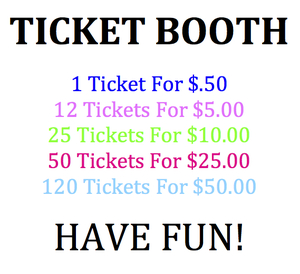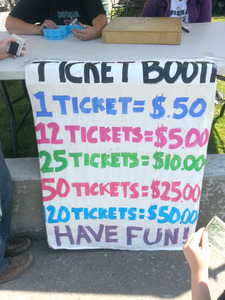Ticket Booth
Task
A school carnival ticket booth posts the following sign:

- Which amount of tickets offers the best deal? Explain.
- How would you suggest the students running the ticket booth modify the list of prices?
IM Commentary
The goal of this task is to compare unit rates in a real world context. Some of the numbers, for example 12 tickets for $5, do not give a whole number of cents per ticket. There are, however, good methods to compare this rate to the other rates without actually calculating the unit rate. In addition to solving the problem by finding unit rates, students could also make a ratio table. One advantage to the ratio table is that it supports the possibility of finding a unit rate while also allowing other thinking. For small numbers of tickets, students could use a tape diagram (or a double number line) but the size of the different groups of tickets make this challenging to do accurately.
This task was based upon an image shown here as taken from Robert Kaplinsky's blog http://robertkaplinsky.com/carnival-ride which contains student work and many other interesting insights about this problem:

This photograph was not used for the task statement because of the inappropriate use of the equals sign: the tickets cost a certain amount of money rather than equal that amount of money. In general, an equals sign should only be used with other mathematical symbols. Alternatively, teachers could use this picture and have students critically analyze how the sign has been laid out as well as solve the problem. This task has been developed in collaboration with a group of teachers from Washington and Illinois. This task was written as part of a collaborative project between Illustrative Mathematics, the Smarter Balanced Digital Library, the Teaching Channel, and Desmos.
Solutions
Solution: 6.RP.A.2 Finding the price per ticket
-
For some of the groups of tickets, the price per ticket is a whole number of cents. With 25 tickets for \$10, the tickets will cost \$10 $\div$ 25 each. Since \$10 is the same as 1000 cents each ticket costs 1000 $\div$ 25 = 40 cents. Similarly with \$25 for 50 tickets this is the same as 2500 cents for 50 tickets or 2500 $\div$ 50 = 50 cents per ticket. So the 50 tickets cost the same per ticket as the individual tickets while the groups of 25 tickets cost less per ticket. The other two possibilities, 12 tickets for \$5 and 120 tickets for \$50 are the same price per ticket because there are 10 groups of 12 tickets in 120 tickets and 10 groups of \$5 in \$50. The price per ticket is not a whole number of cents because \$5 is 500 cents and 500 is not evenly divisible by 12. The quotient is 41$\frac{2}{3}$ cents so the price per ticket when we buy 5 or 50 tickets is a little less than 42 cents per ticket. The cheapest tickets are the groups of 25, followed next by the groups of 12 and 120, with the most expensive tickets being the individual ones and the groups of 50.
Here is all of the information from the previous paragraph in a table:
Group size of tickets Total price (in dollars) Price per ticket (in cents) 1 0.5 50 12 5 41$\frac{2}{3}$ 25 10 40 50 25 50 120 50 41$\frac{2}{3}$ -
It is in the interest of the carnival hosts to sell as many tickets as possible. One way to encourage this is to make the larger groups of tickets less expensive per ticket. The way they have set it up, the groups of 25 tickets offer the best value. No one should purchase groups of 50 tickets because it is a better deal to buy two groups of 25 tickets and similarly no one should purchase groups of 120 tickets because it is a better deal to purchase 5 groups of 25 tickets.
Solution: 6.RP.A.3.a Ratio Tables
-
One way to compare the ticket prices is with ratio tables. For example, to compare 1 ticket for 50 cents with 12 tickets for \$5, we have
Number of Tickets Purchased 50 cents per ticket \$5 for 12 tickets 1 \$0.50 -- 12 \$6 \$5 Since it costs more to buy 12 individual tickets than to buy 12 tickets for \$5, the tickets priced at \$5 for 12 are a better deal. Notice that we could also calculate the blank spot in the table for the price of a single ticket when we buy a batch of 12 tickets for \$5. This is \$5 $\div$ 12 = 41$\frac{2}{3}$ cents, less than the 50 cents for buying a single ticket. So again, the tickets are cheaper if we buy them in groups of 12 than buying them individually.
To compare the tickets priced at \$5 for 12 with those priced at \$10 for 25 we have:
Number of Tickets Purchased \$5 for 12 tickets \$10 for 25 tickets 12 \$5 -- 24 \$10 -- 25 -- \$10 Since we get one extra ticket for \$10 when we by a group of 25 tickets, this is a better deal than buying 2 groups of 12 tickets for \$5. Alternatively we could continue the table, finding a common multiple of 12 and 25:
Number of Tickets Purchased \$5 for 12 tickets \$10 for 25 tickets 300 25 $\times$ \$5 = \$125 12 $\times$ \$10 = \$120 Again, the tickets that cost \$10 for 25 are a better deal than the tickets at \$5 for 12. There are many other options available here to compare these two ways of buying tickets: we could find the price per ticket in each scenario (which is done in the first solution). Or we could find the price for 12 tickets in the 25 ticket option, namely $\frac{12}{25} \times$ \$10 = \$4.80.
The other two options for buying tickets, 50 tickets for \$25 and 120 tickets for \$50 are equivalent to ratios we have already seen. Paying \$25 for 50 tickets is the same as buying 50 individual tickets for \$0.50 while buying 120 tickets for \$50 is the same as buying 10 groups of 12 tickets for \$5.
The ratio table method and the unit rate method come together if we look for the price of 1 ticket in each of the different scenarios. On the other hand, the ratio table method is more flexible as we can compare the prices for any number of tickets purchased via the different methods.
Ticket Booth
A school carnival ticket booth posts the following sign:

- Which amount of tickets offers the best deal? Explain.
- How would you suggest the students running the ticket booth modify the list of prices?
